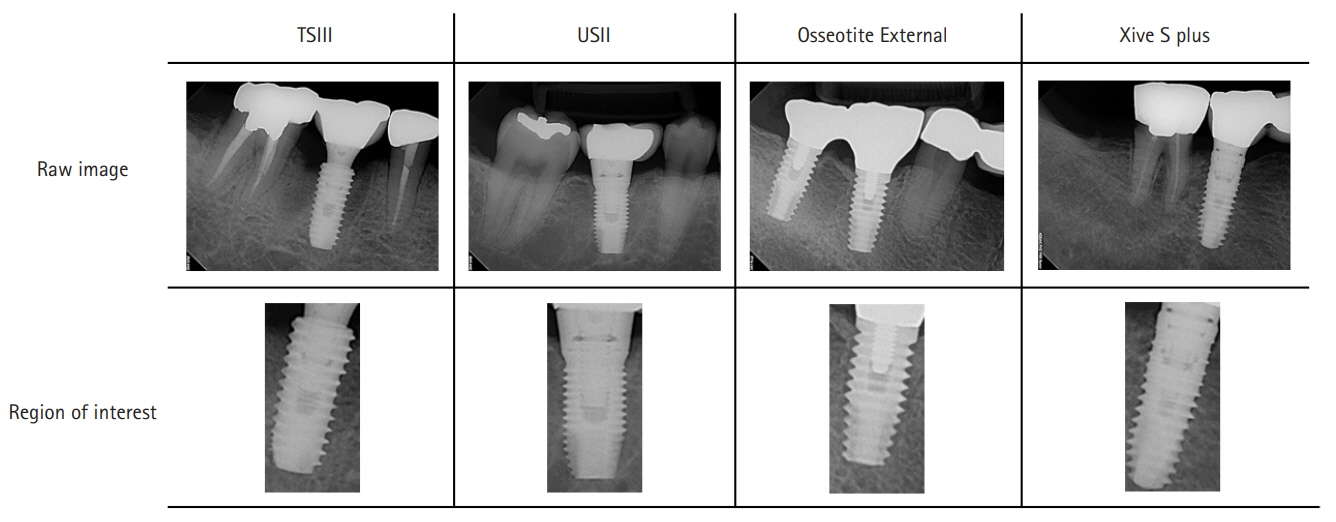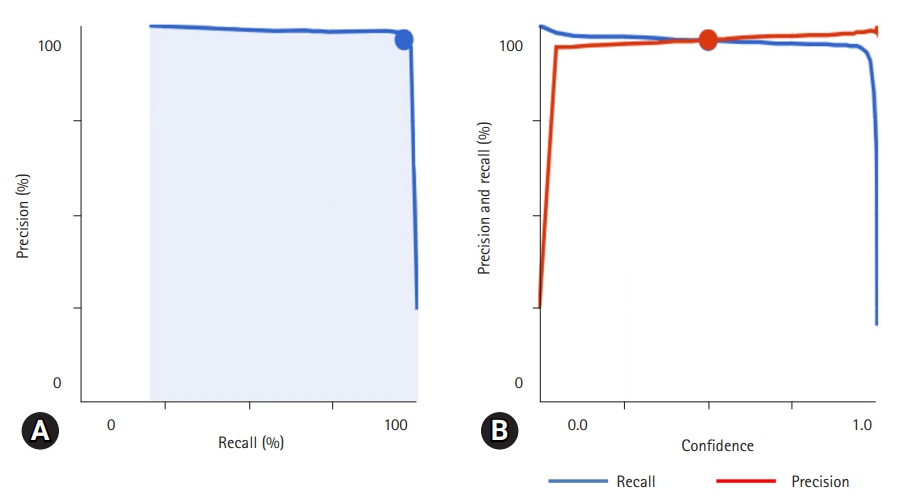J Yeungnam Med Sci.
2023 Nov;40(Suppl):S29-S36. 10.12701/jyms.2023.00465.
Classification of dental implant systems using cloud-based deep learning algorithm: an experimental study
- Affiliations
-
- 1Department of Prosthodontics, College of Dentistry, Wonkwang University, Iksan, Korea
- KMID: 2548340
- DOI: http://doi.org/10.12701/jyms.2023.00465
Abstract
- Background
This study aimed to evaluate the accuracy and clinical usability of implant system classification using automated machine learning on a Google Cloud platform.
Methods
Four dental implant systems were selected: Osstem TSIII, Osstem USII, Biomet 3i Os-seotite External, and Dentsply Sirona Xive. A total of 4,800 periapical radiographs (1,200 for each implant system) were collected and labeled based on electronic medical records. Regions of interest were manually cropped to 400×800 pixels, and all images were uploaded to Google Cloud storage. Approximately 80% of the images were used for training, 10% for validation, and 10% for testing. Google automated machine learning (AutoML) Vision automatically executed a neural architecture search technology to apply an appropriate algorithm to the uploaded data. A single-label image classification model was trained using AutoML. The performance of the mod-el was evaluated in terms of accuracy, precision, recall, specificity, and F1 score.
Results
The accuracy, precision, recall, specificity, and F1 score of the AutoML Vision model were 0.981, 0.963, 0.961, 0.985, and 0.962, respectively. Osstem TSIII had an accuracy of 100%. Osstem USII and 3i Osseotite External were most often confused in the confusion matrix.
Conclusion
Deep learning-based AutoML on a cloud platform showed high accuracy in the classification of dental implant systems as a fine-tuned convolutional neural network. Higher-quality images from various implant systems will be required to improve the performance and clinical usability of the model.
Keyword
Figure
Reference
-
References
1. Steigenga JT, al-Shammari KF, Nociti FH, Misch CE, Wang HL. Dental implant design and its relationship to long-term implant success. Implant Dent. 2003; 12:306–17.
Article2. Adell R, Lekholm U, Rockler B, Brånemark PI. A 15-year study of osseointegrated implants in the treatment of the edentulous jaw. Int J Oral Surg. 1981; 10:387–416.
Article3. van Steenberghe D, Lekholm U, Bolender C, Folmer T, Henry P, Herrmann I, et al. Applicability of osseointegrated oral implants in the rehabilitation of partial edentulism: a prospective multicenter study on 558 fixtures. Int J Oral Maxillofac Implants. 1990; 5:272–81.4. Buser D, Weber HP, Bragger U, Balsiger C. Tissue integration of one-stage ITI implants: 3-year results of a longitudinal study with Hollow-Cylinder and Hollow-Screw implants. Int J Oral Maxillofac Implants. 1991; 6:405–12.
Article5. Adell R, Eriksson B, Lekholm U, Brånemark PI, Jemt T. Long-term follow-up study of osseointegrated implants in the treatment of totally edentulous jaws. Int J Oral Maxillofac Implants. 1990; 5:347–59.6. Al-Johany SS, Al Amri MD, Alsaeed S, Alalola B. Dental implant length and diameter: a proposed classification scheme. J Prosthodont. 2017; 26:252–60.
Article7. Michelinakis G, Sharrock A, Barclay CW. Identification of dental implants through the use of Implant Recognition Software (IRS). Int Dent J. 2006; 56:203–8.
Article8. Jokstad A, Braegger U, Brunski JB, Carr AB, Naert I, Wennerberg A. Quality of dental implants. Int Dent J. 2003; 53(6 Suppl 2):409–43.
Article9. Oshida Y, Tuna EB, Aktören O, Gençay K. Dental implant systems. Int J Mol Sci. 2010; 11:1580–678.
Article10. Jokstad A, Ganeles J. Systematic review of clinical and patient-reported outcomes following oral rehabilitation on dental implants with a tapered compared to a non-tapered implant design. Clin Oral Implants Res. 2018; 29(Suppl 16):41–54.
Article11. Lee KY, Shin KS, Jung JH, Cho HW, Kwon KH, Kim YL. Clinical study on screw loosening in dental implant prostheses: a 6-year retrospective study. J Korean Assoc Oral Maxillofac Surg. 2020; 46:133–42.
Article12. Dudhia R, Monsour PA, Savage NW, Wilson RJ. Accuracy of angular measurements and assessment of distortion in the mandibular third molar region on panoramic radiographs. Oral Surg Oral Med Oral Pathol Oral Radiol Endod. 2011; 111:508–16.
Article13. Kayal RA. Distortion of digital panoramic radiographs used for implant site assessment. J Orthod Sci. 2016; 5:117–20.
Article14. Golden JA. Deep learning algorithms for detection of lymph node metastases from breast cancer: helping artificial intelligence be seen. JAMA. 2017; 318:2184–6.
Article15. Yasaka K, Akai H, Kunimatsu A, Kiryu S, Abe O. Deep learning with convolutional neural network in radiology. Jpn J Radiol. 2018; 36:257–72.
Article16. Hwang JJ, Jung YH, Cho BH, Heo MS. An overview of deep learning in the field of dentistry. Imaging Sci Dent. 2019; 49:1–7.
Article17. Casalegno F, Newton T, Daher R, Abdelaziz M, Lodi-Rizzini A, Schürmann F, et al. Caries detection with near-infrared transillumination using deep learning. J Dent Res. 2019; 98:1227–33.
Article18. Kim JE, Nam NE, Shim JS, Jung YH, Cho BH, Hwang JJ. Transfer learning via deep neural networks for implant fixture system classification using periapical radiographs. J Clin Med. 2020; 9:1117.
Article19. Sukegawa S, Yoshii K, Hara T, Yamashita K, Nakano K, Yamamoto N, et al. Deep neural networks for dental implant system classification. Biomolecules. 2020; 10:984.
Article20. Takahashi T, Nozaki K, Gonda T, Mameno T, Wada M, Ikebe K. Identification of dental implants using deep learning-pilot study. Int J Implant Dent. 2020; 6:53.
Article21. Park W, Schwendicke F, Krois J, Huh JK, Lee JH. Identification of dental implant systems using a large-scale multicenter data set. J Dent Res. 2023; 102:727–33.
Article22. Kong HJ, Eom SH, Yoo JY, Lee JH. Identification of 130 dental implant types using ensemble deep learning. int j oral maxillofac implants. 2023; 38:150–6.
Article23. Deo RC. Machine learning in medicine. Circulation. 2015; 132:1920–30.
Article24. Stead WW. Clinical implications and challenges of artificial intelligence and deep learning. JAMA. 2018; 320:1107–8.
Article25. Kim IK, Lee K, Park JH, Baek J, Lee WK. Classification of pachychoroid disease on ultrawide-field indocyanine green angiography using auto-machine learning platform. Br J Ophthalmol. 2021; 105:856–61.
Article26. Zeng Y, Zhang J. A machine learning model for detecting invasive ductal carcinoma with Google Cloud AutoML Vision. Comput Biol Med. 2020; 122:103861.
Article27. Faes L, Wagner SK, Fu DJ, Liu X, Korot E, Ledsam JR, et al. Automated deep learning design for medical image classification by health-care professionals with no coding experience: a feasibility study. Lancet Digit Health. 2019; 1:e232–42.
Article28. Park W, Huh JK, Lee JH. Automated deep learning for classification of dental implant radiographs using a large multi-center dataset. Sci Rep. 2023; 13:4862.
Article29. Griebel L, Prokosch HU, Köpcke F, Toddenroth D, Christoph J, Leb I, et al. A scoping review of cloud computing in healthcare. BMC Med Inform Decis Mak. 2015; 15:17.
Article30. Li Z, Guo H, Wang WM, Guan Y, Barenji AV, Huang GQ, et al. A blockchain and AutoML approach for open and automated customer service. IEEE Trans Ind Inform. 2019; 15:3642–51.
Article31. Lee JH, Jeong SN. Efficacy of deep convolutional neural network algorithm for the identification and classification of dental implant systems, using panoramic and periapical radiographs: a pilot study. Medicine (Baltimore). 2020; 99:e20787.32. Wu S, Wu X, Shrestha R, Lin J, Feng Z, Liu Y, et al. Clinical and radiologic outcomes of submerged and nonsubmerged bone-level implants with internal hexagonal connections in immediate implantation: a 5-year retrospective study. J Prosthodont. 2018; 27:101–7.
Article33. Uraz A, Isler SC, Cula S, Tunc S, Yalim M, Cetiner D. Platform-switched implants vs platform-matched implants placed in different implant-abutment interface positions: a prospective randomized clinical and microbiological study. Clin Implant Dent Relat Res. 2020; 22:59–68.
Article34. Karl M, Irastorza-Landa A. In vitro characterization of original and nonoriginal implant abutments. Int J Oral Maxillofac Implants. 2018; 33:1229–39.
Article
- Full Text Links
- Actions
-
Cited
- CITED
-
- Close
- Share
- Similar articles
-
- Deep Learning in Dental Radiographic Imaging
- Exploiting the Vulnerability of Deep Learning-Based Artificial Intelligence Models in Medical Imaging: Adversarial Attacks
- Deep learning algorithms for identifying 79 dental implant types
- Deep Learning Based Radiographic Classification of Morphology and Severity of Peri-implantitis Bone Defects: A Preliminary Pilot Study
- Transfer learning in a deep convolutional neural network for implant fixture classification: A pilot study





